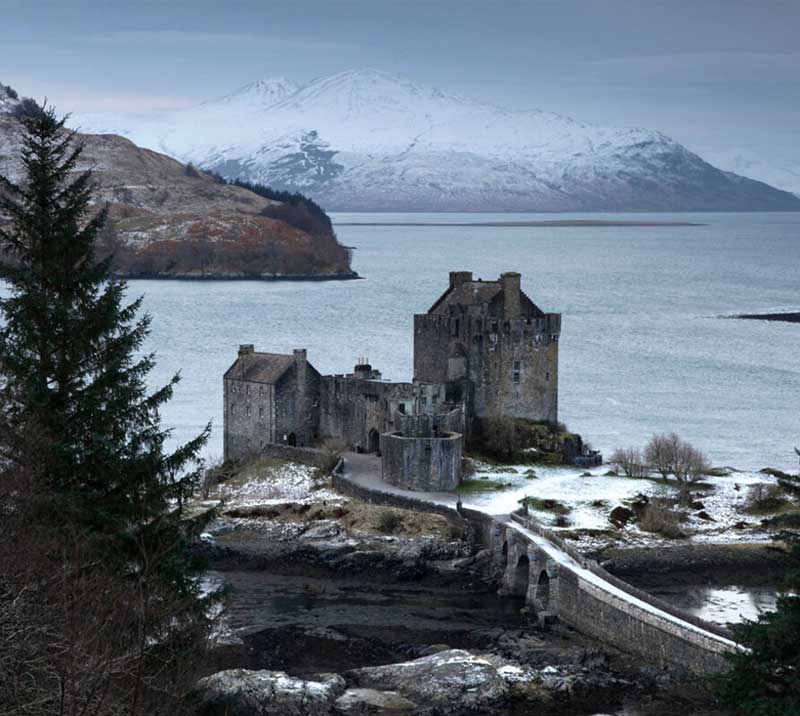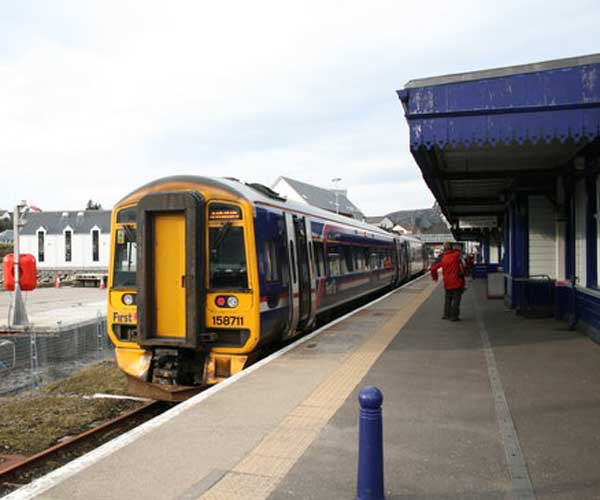Kyle of Lochalsh Line, Scotland

Travel coast to coast across the Highlands, in the shadows of
mountains and forests, beside bright lochs and wide open moors. The
Kyle line draws a wide arc from Inverness to the shores of Loch Alsh,
taking in spectacular Highland scenery – and finishing with
magnificent views of Skye.
Just outside Inverness lies Dingwall, a pretty market town that’s
perfect for a stop off or a connection to the Far North Line. From
there, the train takes you past lochs and moors as you travel through
the Highlands. Keep an eye out for one of the most distinctive mountain
ranges in Scotland, the Torridon Peaks, looming out of the north. On
the final stretch of the journey, the train picks its way along the
coast south to Loch Alsh.
Inverness to Kyle of Lochalsh - approx 2 hours 40 minutes.

The Journey
The Kyle of Lochalsh Line is a primarily single track railway line
in the Scottish Highlands, running from Dingwall to Kyle of Lochalsh.
Many of the passengers on the trains are tourists but one can also
expect to meet locals visiting Inverness for shopping, and commuters.
All services are provided by Abellio ScotRail and run to Inverness.
Most services run to or from Inverness; one daily train runs beyond
Inverness to Elgin (in the current 2016 timetable) having in the past
come from Glasgow, Edinburgh or Aberdeen. No section of the line is
electrified and all trains on the line are diesel-powered, as are all
other trains in the Scottish Highlands.
The train leaves Inverness to glide along the southern bank of the
Beauly Firth, through Dingwall and on to Garve – keep an eye out
for Ben Wyvis just after Dingwall, a huge isolated mountain to the
north. From there the line crosses the wild Highland mountainscape
between Lochs Luichart and Carron. Look out for the Torridon Peaks on
the western side: you can’t miss the great hulk of rock in the
distance.
At the other end of Loch Carron you’ll find Plockton. Stop off to
explore the pretty town – complete with palm trees – then
spot the locations used for BBC series Hamish Macbeth, and The Wicker
Man. And on the last stretch towards Kyle of Lochalsh, the views of
Skye are spectacular.
Consider stopping at
Plockton for its beautiful bay – the town was used for the BBC series Hamish Macbeth and scenes in The Wicker Man
Attadale for Attadale Gardens – for 20 acres of Scottish Highland gardens on Wester Ross
Look out for
The Torridon Peaks – to the west, just before the stop at Achnashellach Forest
Herds of deer – on the downhill route from Loch Luichart to Garve
Ben Wyvis – an isolated mountain visible between Muir of Ord and Dingwall
The Service
From 1999 onwards, the then ScotRail operator, National Express,
began the removal of the Class 156 "Sprinter" trains. Their replacement
was to be the faster, higher standard Class 158s. These trains offered
a better all round travelling experience, with air conditioning,
improved speed, lighting, seating, storage and general comfort. There
is now a dedicated fleet of Class 158 units based at Inverness serving
the Kyle of Lochalsh line, the Far North Line to Wick and Thurso, and
the Aberdeen to Inverness Line. The next franchise owner First ScotRail
had continued the current situation, with improvement to the depot
facilities at Inverness.
During the winter months there are three, generally 2 car services, per
day in each direction, with no Sunday services. During summer months,
Monday to Saturday services increase to four in both directions, mostly
running as 4 cars, with two services in each direction on a Sunday.
Service enhancements have seen the introduction of four daily trains
all year round, Monday - Saturday.
The stations on the line that have passing loops are Muir of Ord, Dingwall, Garve, Achnasheen and Strathcarron. Only Dingwall and Kyle stations are staffed, however all stations along the route have lighting and passenger information posters with train timetable details. Most have passenger information telephone points fitted so that remote customer service staff can be contacted. Normal office hours apply. Along the route there are 29 bridges and 31 cuttings.
History of The Line
The route was built in three sections:
Inverness and Ross-shire Railway between Inverness and Dingwall
Dingwall and Skye Railway between Dingwall and Stromeferry
Kyle of Lochalsh Extension (Highland Railway) between Stromeferry and Kyle of Lochalsh
The Strathpeffer Branch operated between 1885 and 1951.
In the 1960s the line was listed to be closed under the Reshaping of British Railways report, however it was reprieved and services continued. In 1989 the bridge over the River Ness at Inverness was washed away, leaving both it and the Far North Line stranded, but new "Sprinter" trains were brought over by road, and a temporary yard was built to service them at Muir of Ord. The section of line along Loch Carron is particularly troublesome and prone to landslides, often closing that section.
Whilst undeniably a rural line, a historic term in the Act of Parliament for the railways here and around Inverness means that one through service per day is operated over the line towards Aberdeen (see above), whereas all other services start and finish at Inverness.
The Kyle of Lochalsh Line was featured in Eddie McConnell's lyrical documentary The Line to Skye (1973) with commentary by Scottish writer William McIlvanney, commissioned as part of Ross and Cromarty's campaign to keep the line open at a time when it was threatened with closure. The film follows the train from Inverness to Kyle of Lochalsh, describing the communities, landscape and wildlife along its route, while contrasting the frustration of motorists with the relaxation of the journey by rail.
Design by W3layouts

